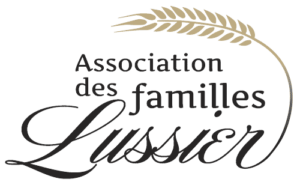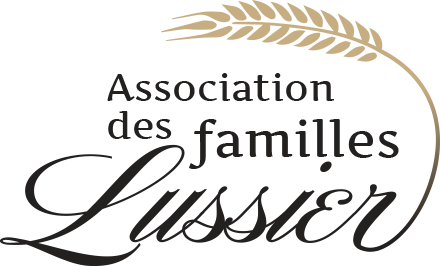
A brief chronology of events in New France
Contextualizing the milestones for Jacques Lussier’s descendants
Most information are from from www.wikipédia.org
1608
July 3: Samuel de Champlain founds Quebec City. The facility employs 28 people. Over the winter, 20 of the 28 men die.
1617
Louis Hébert, the colony’s first farmer, settled in Quebec City with his wife, Marie Rollet, and their three children.
1625
Arrival of the Jesuits.
1627
There were just under 100 inhabitants in New France, including less than a dozen women. – Cardinal Richelieu founds the Compagnie des Cent-Associés, dedicated to settling the colony.
1632
Treaty of Saint-Germain-en-Laye: England returns New France and [ Acadia ] to France.
1634
On Champlain’s orders, Sieur Laviolette founded Trois-Rivières .
1636
Population of New France: 400.
1639
Arrival of the ‘Ursulines’ and the ‘Hospitalières’ congregations.
1642
May 17: Ville-Marie (Montreal), a missionary city, is founded by a devout layman, Paul Chomedey de Maisonneuve.
1643
June 9: the Iroquois begin harassing the small Montreal community with a war of ambushes. They kill five settlers. Establishment of the New England Confederacy, formed by the English colonies of New Haven, Connecticut, and Plymouth, Massachusetts.
1645
March 6: the Cent-Associés cede their trading monopoly to the Communauté des Habitants de la Nouvelle-France. For the first time, the great fur trade would be conducted under the direction and for the direct profit of the colony’s established merchants. This community is at the origin of the great trading families of the French Regime.
Our ancestor Jacques Lussier was born around 1646, in Paris.
1647
1647: Birth of Charlotte Lamarche, Paris. First wife of Jacques Lussier
1653
Sept. 22 Maisonneuve returns from France with 100 soldiers hired to defend Montreal against the Iroquois. On board the ship was Marguerite Bourgeoys, who had come to open a school. She writes that everything in Quebec City is so poor it’s pitiful. When she arrived in Montreal, she couldn’t find any school-age children because of the high infant mortality rate.
1658
In Montreal, Marguerite Bourgeoys inaugurates her first school and founds the Congrégation Notre-Dame.
1659
Two hundred people set sail from La Rochelle for New France, the largest effort to date to populate the colony. A good third of them died at sea, and only sick people were brought ashore in Quebec, introducing smallpox to the colony.
1660
In spring, Adam Dollard des Ormeaux and his 16 companions set out on an expedition up the Ottawa River to fight the Iroquois. Some forty Hurons and six Algonquins join them. At the foot of the Long-Sault rapids, they barely have time to refurbish an old abandoned fort before they face 800 besiegers. After three days of fighting, the 17 Frenchmen were killed. General panic in Quebec City. Six Iroquois are captured, tortured and burned at the stake.
1663
1665
First census: 3215 inhabitants. – The French government sent “filles du roi” (orphans raised at the king’s expense) and forced bachelors to choose a wife from among them. By 1673, 900 of them had arrived. – Jean Talon is appointed the colony’s first intendant. Dynamic, enthusiastic and resourceful, he wants to expand the kingdom of France here. Despite the king’s lack of interest in the colony, he worked hard to develop it.
Carignan-Salières
1669
Jacques Lussier was present in Québec City in the fall of 1669, when he drew up his first marriage contract with Charlotte Lamarche. To date, this is the oldest archival document in which our ancestor’s name is mentioned in America. Charlotte Lamarche, a fille du Roy, arrived on June 30 on the ship Saint-Jean-Baptiste.
1670
Backers of Radisson and Des Groseillers, the English formed the Hudson’s Bay Company, a company that established England’s right to trade in the hinterland of New France.
Jacques and Charlotte make their home in the seigneury of Cap de Varennes. In the summer of 1670, a contract was signed for the construction of their house.
1671
On February 3, 1671, Charlotte gave birth to a baby girl, Marie. Unfortunately, the young mother did not survive childbirth. On October 12, Jacques married Catherine Clérice, another fille du Roy. Over the next few years, 12 children followed in the family cradle. Nine of their children will reach adulthood and marry. They all settled in the Varennes area.
1672
Frontenac becomes Governor of New France. – Before leaving the colony, Talon distributed 46 seigneuries, the highest number ever achieved in a single year.
First Varennes settlers.
1673
Louis Jolliet and Jacques Marquette explore the Wisconsin, Mississippi and Illinois rivers.
1682
La Salle sailed down the Mississippi to its mouth and took possession of this immense basin on behalf of the King of France. The French empire in America stretched from Quebec to the Mississippi delta.
1687
Measles epidemic throughout the colony. In Sillery alone, 100 Amerindians died.
1688
Population of New France: 10,303. Quebec City has 1,400.
1690
Admiral Phipps lays siege to Québec. Frontenac replies to his emissary: “I have no reply to make to your general other than by the mouths of my cannons and with rifles. Frontenac defeats the English soldiers, weakened by an epidemic. – Acadia is reconquered by the English.
1692
Madeleine de Verchères, aged 14, escapes the pursuing Iroquois by taking refuge in her father’s fort at Verchères. Mounted on the bastion, soldier’s hat on head, she goes here and there, letting the Amerindians believe that many soldiers occupy the fort. Then the cannon shot she fires at them causes them to scatter.
1701
Signing of the Great Peace of Montreal with the 39 Amerindian tribes and the Five Nations of the Iroquois.
https://fr.wikipedia.org/wiki/1701_au_Canada
1711
The entire summer was spent on the alert, fearing that the English would once again attack New France, this time via the St. Lawrence and the Great Lakes. On the night of September 2 to 3, a storm threw Walker’s ships onto the rocks of Île aux Oeufs, 467 km downstream from Quebec City, thus sparing the colony from another English attack.
1712
Jacques Lussier drowned in the St. Lawrence River between November 14, 1712 and January 22, 1713. His body was found in the seigneury of Sorel the following summer. It was here that he was buried on June 12, 1713, in the presence of his son Christophe and his son-in-law Antoine Foisy.
1713
Signature of the Treaty of Utrecht, disastrous for France. England seized the outposts of the colony, gaining Newfoundland, Acadia, Hudson Bay and a protectorate over the Iroquois. New France is reduced to a long corridor along the shores of the St. Lawrence. But it remained peaceful until 1744.
1715
In the winter of 1715, after receiving the last rites, it was Catherine’s turn to leave her family at the age of 68. On March 1, 1715, his body was buried in the Varennes parish cemetery.
1716
For fear of being attacked again by the English, fortifications were built in Montreal and Quebec City. In Montreal, it was decided to surround the city with a stone wall flanked by bastions on the site now known as Faubourg-Québec.
1721
Colony population: 24,951. – June 19: in Montreal, on the occasion of Corpus Christi, a harquebusier fires on the roof of the Hôtel-Dieu chapel: 171 houses burn down.
1735
From Quebec City to Montreal, on the north shore of the St. Lawrence, the Chemin du Roy is inaugurated, a four-year project involving 13 bridges. The journey from one city to another on a single horse now takes four days.
1738
Production begins at the Forges du Saint-Maurice near Trois-Rivières.
1739
Beaver pelts account for 70% of the value of exports.
1744
In his account of his travels in New France, Father Charlevoix notes: “Nowhere else is our language spoken more purely. In 1756, Montcalm wrote: “I have observed that the Canadian peasants speak French very well.” The following year, Bougainville’s navigator added: “They speak with ease … their accent is as good as in Paris.”
1745
Capture of the fortress of Louisbourg by the English, returned in 1748. In Quebec City, for fear of a new invasion, a permanent wall was built.
1749
Voyage to New France by the Swede Peter Kalm. The men are extremely polite,” he observes. Here, everyone is Monsieur or Madame, the peasant as well as the gentleman, the peasant girl as well as the grandest lady … the country people [ … ] are always in a cheerful and gaudy mood … People of distinction in general have much more taste for natural history and letters than in the English colonies, where everyone’s sole concern seems to be to make a quick fortune…”
1754
New France had a population of 55,000, and Quebec City 8,000. – The English colonies in North America have a population of around 1,500,000.
1755
In July, Nova Scotia’s Executive Council unanimously decides to deport the Acadians. Before the end of the year, under the orders of English governor Lawrence, 7,000 Acadians left for exile.
1756
The Marquis de Montcalm captures the English fort at Oswego. – France expels England from the Great Lakes region.
1757
Summer and autumn of misery: poor harvests, ships seized by the English, famine, typhus and smallpox epidemics. In winter, for lack of food, horses were eaten for the first time in the colony.
1759
In June, General Wolfe undertakes the siege of Quebec with a fleet of 39,000 men – September 13: Battle of the Plains of Abraham and defeat of Montcalm’s armies. Wolfe and Montcalm are killed. September 17: at noon, de Ramezay hands over the city of Quebec to General Townshend.
Today, the descendants of Jacques Lussier and his two wives number in the tens of thousands in North America. They are scattered throughout Quebec, Ontario, Western Canada, New England and many other American states (e.g. Oregon, Minnesota, etc.).

